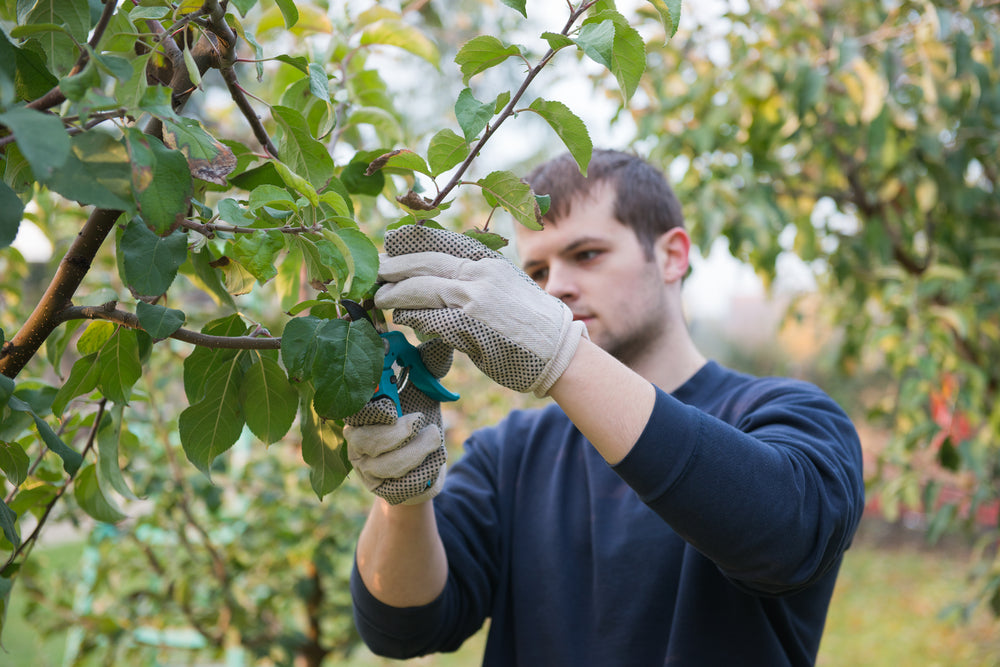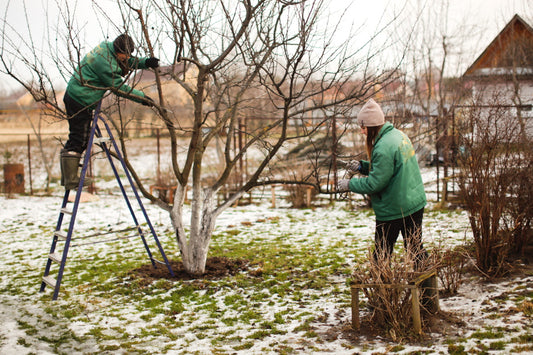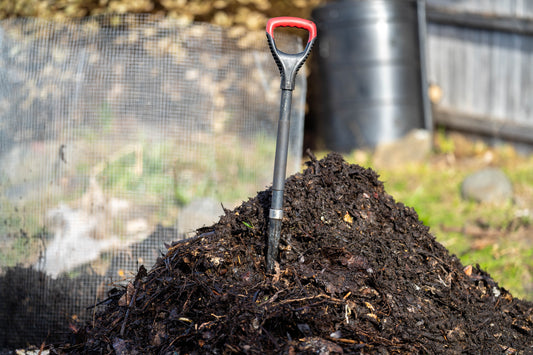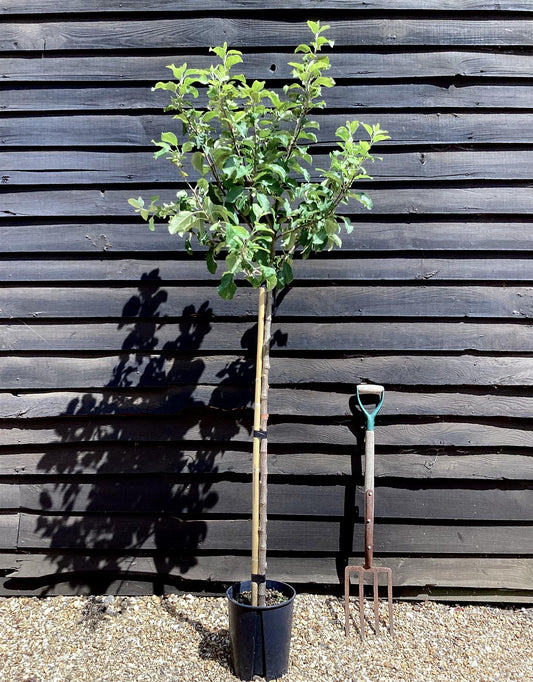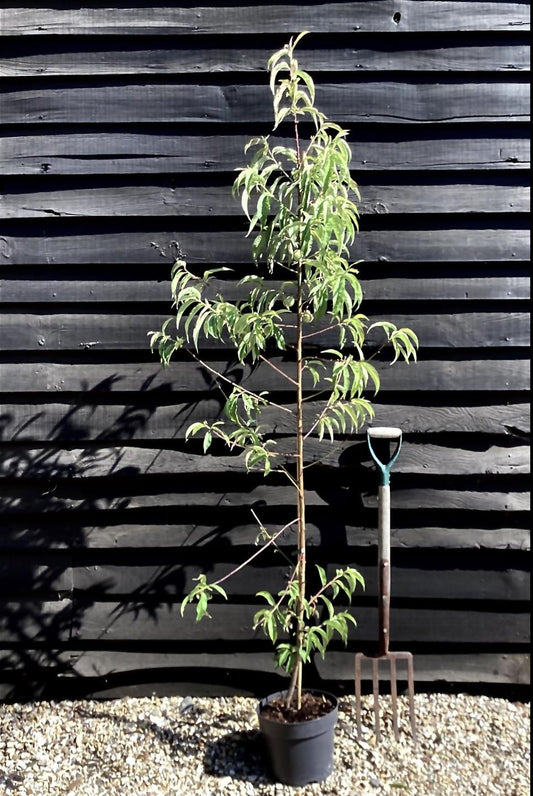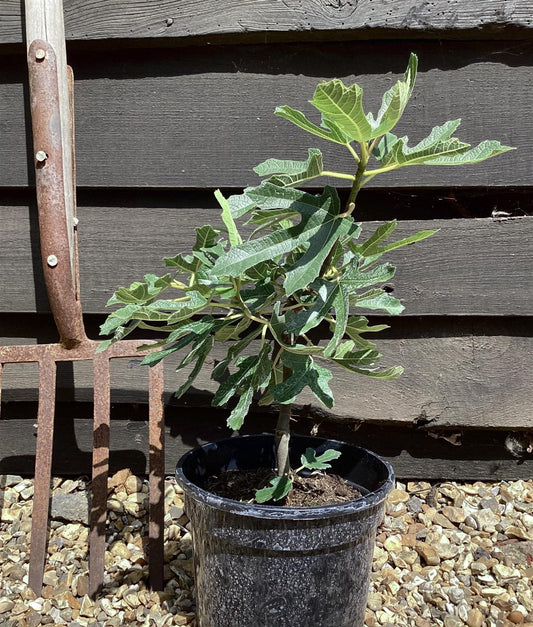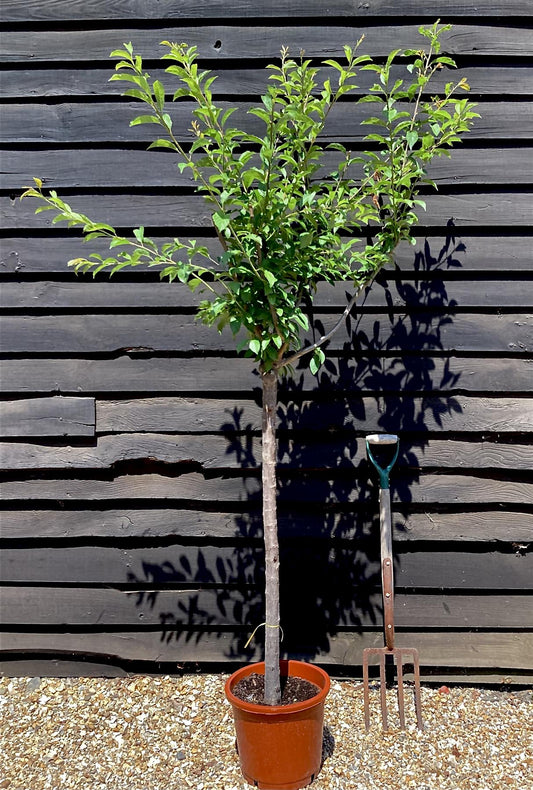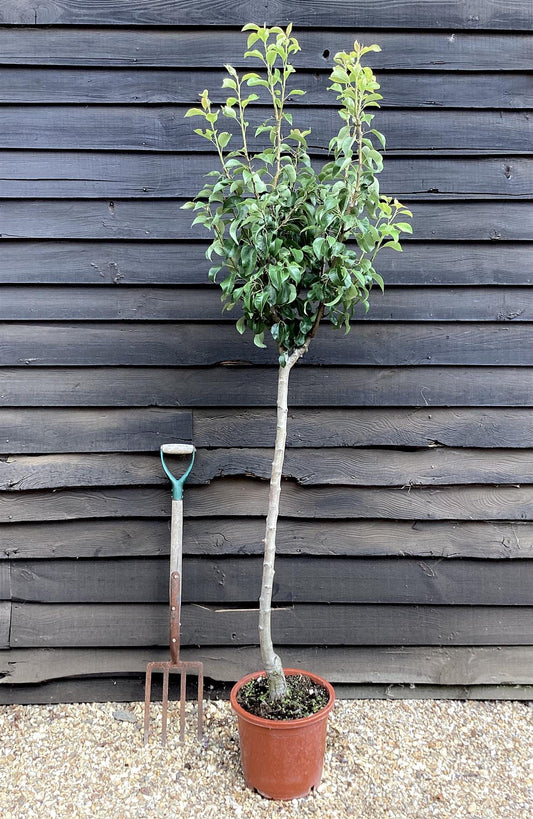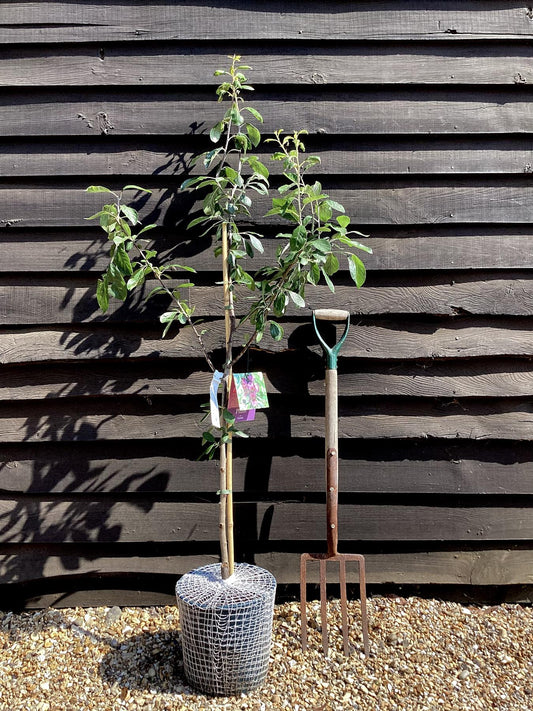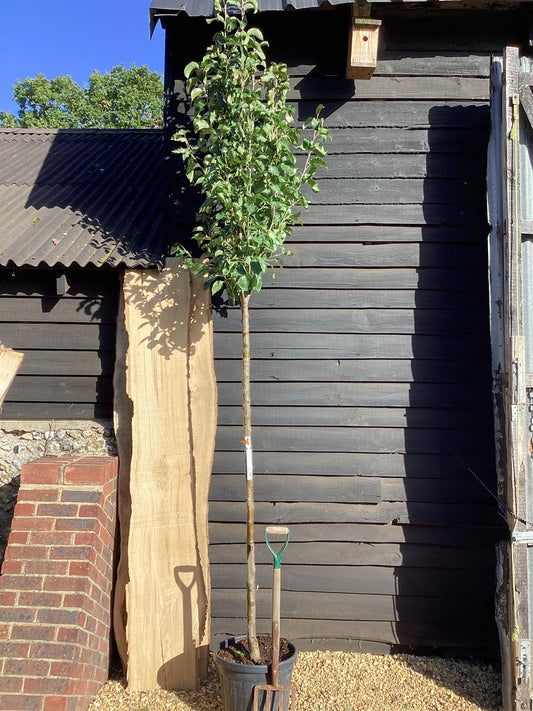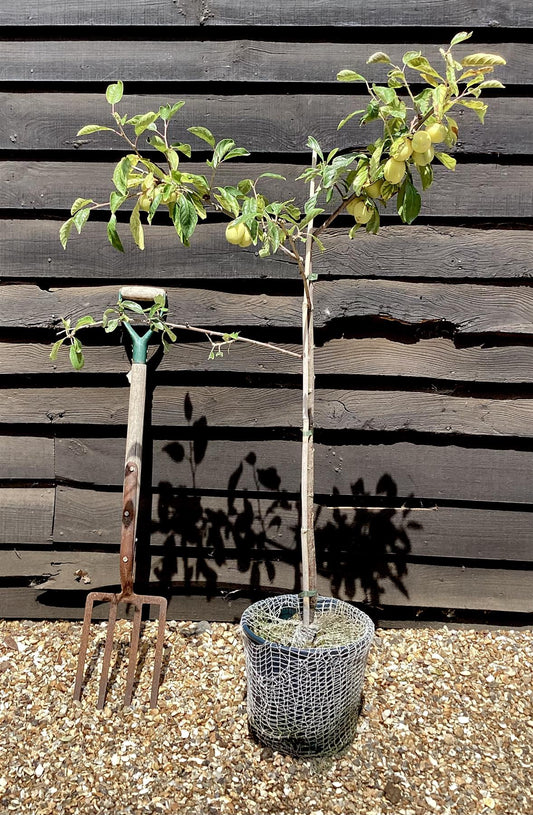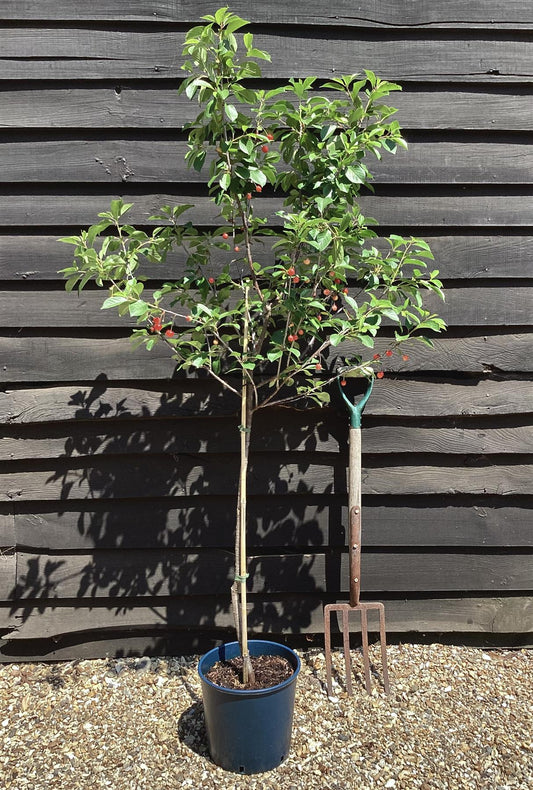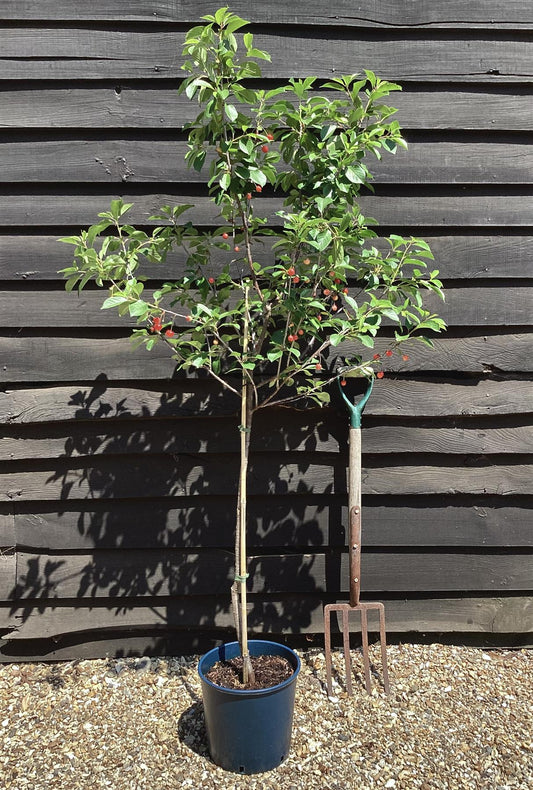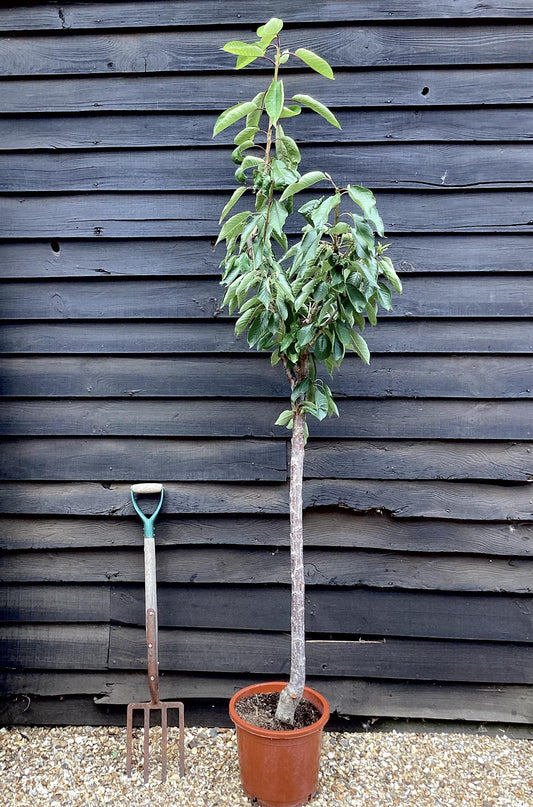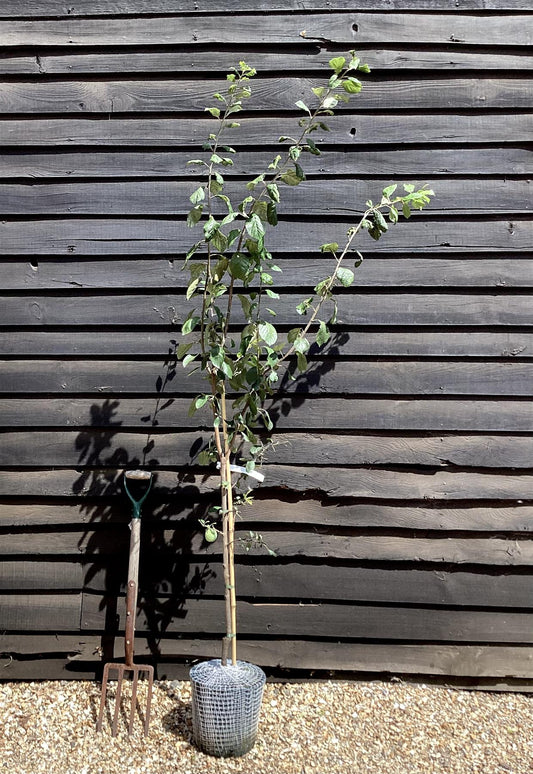Your young apple tree is a story waiting to unfold, with you as a guide nurturing its growth and helping it reveal its full potential. Pruning is just a step in this transformative journey, setting the stage for a fruitful “happily ever after”. Here are some helpful tips for mastering the art of pruning, ensuring your apple tree grows strong and bears the perfect fruit.
Start Pruning at Planting
Why prune new trees? It's a perfectly reasonable question to ask, but there is a valid reason to start pruning at the time of planting.
When you welcome a young tree into your garden, careful and thoughtful trimming will prepare it for a lifetime of lush growth. While many gardeners, even experienced ones, will say that pruning newly planted trees compensates the root loss or helps the tree survive the planting, the latest research shows that is not quite true.
Pruning cannot compensate for root loss and doesn’t help the tree in overcoming the shock of transplantation. The more leaves you leave on the tree, the happier and healthier roots will be in their new home. As we already know, leaves turn sunlight into energy, and that energy fuels the root growth and helps it get over the shock of moving.
Then, why pruning when planting? Pruning at the time of planting is for structure only. It should be done to establish the best possible structure to help it grow strong and beautiful in the future.
How to Prune a Young Apple Tree?
The first pruning should be done immediately after planting. The critical question of when to prune a new apple tree is, therefore, closely connected to its planting period. The best time to plant a new apple tree is from late November to early March, while the tree is still dormant. That’s also the time when you should do the first pruning.
Young apple trees are sold in three main forms. Understanding these forms of young apple trees is crucial for effective pruning. These three main forms of a young apple tree available for sale are:
- Unfeathered Maiden
- Feathered Maiden
- Two-Year-Old Tree
The main goal of pruning a young apple tree is to form a strong central leader or a trunk by removing branches that are growing upright and fighting for dominance with the leader or are too closely spaced. Also removing branches that are damaged or broken can prevent potential future issues.
Unfeathered Maiden (A Single-Stem 1-Year-Old Apple Tree)
An unfeathered maiden is a 1-year-old tree with a single stem or trunk and no side shoots. The main goal of pruning 1-year-old apple trees is to:
- Encourage them to branch out
- Make them stronger
How to Do It:
- Cut the top of the stem just above the bud
- Ensure there are 3 or 4 healthy buds below
- Make the cut about:
- 75cm from the ground for standard and half-standard trees
- 60cm from the ground for a tree on a dwarfing M27 rootstock
This approach encourages the tree to grow lateral branches. The healthy development of these branches is essential for a strong and productive structure. Be aware that you are not just cutting, but guiding your tree towards fulfilling its full potential.
Feathered Maiden (1-Year-Old Apple Tree with Side Shoots)
A feathered maiden is a 1-year-old apple tree with several side shoots on the main stem. The key goal of pruning feathered maiden is to:
- Select well-placed branches
- Create a balanced, open tree structure
- Shape the tree for future growth
How to Do It:
- Examine the tree’s structure
- Identify the central trunk, which is the main upward branch
- Remove any shoots that compete with it
- Choose 3-5 strong, well-spaced, outgrowing branches
- They should be evenly distributed around the trunk
- Ideally, angled 45 to 60 degrees from the trunk
- Cut the top of the main branch (trunk) just above the highest side shoot
- Shorten the branches you previously selected by half to two-thirds
- Cut them just above an outward-facing bud
- Remove any side shoots below them
- Remove damaged or broken branches
By following these steps, your feathered maiden apple tree will be on its way to becoming strong and well-shaped, ready to grow and bear fruit for years to come.
2-Year-Old Apple Tree (Newly Planted or In Its Second Year)
Pruning a Newly Planted 2-Year-Old Apple Tree (Pre-Trained by the Grower)
If your newly bought apple tree is 2 years old, it is probably partly pre-trained. It has likely already started to form a basic structure, but it can still benefit from formative pruning.
Pruning 2-year-old apple trees is similar to pruning feathered maiden trees. The only difference is that with a 2-year-old tree, the main stem or trunk is most probably cut back by the grower but the tree may have sprouted a replacement upright shoot. You need to cut it back just above the highest side shoot.
Pruning the Second Year After Maiden (Two Years in Your Garden)
Pruning your apple tree in its second year in your garden is very important for its robust, healthy growth and abundant fruit production. The goal is to:
- Develop a strong and well-structured framework of branches
- Make the tree capable of bearing the weight of the fruit
Pruning should be done late in winter or early in spring, before the new growth emerges. Here is a simple guide on how to prune a young apple tree in winter.
Hot to Do It:
- Examine the tree’s structure
- Remove competing branches to maintain a single, strong, central leader
- Choose 8 to 10 side shoots evenly spaced around the trunk
- To establish the permanent branching structure
- Remove the branches that are growing vertically, too close, crossing, or rubbing against each other
- Remove shoots that main branches do not need
- Shorten the branches by half to two-thirds
- Cut just above the outward-facing bud
- Remove suckers (growing from the base of the trunk) and water sprouts (upright shoots on branches)
- Remove diseased, dead, or damaged branches
- Keep the centre of the crown open
Pruning in the second year is important for strengthening the structure that was established in the first year. Thoughtful shaping of the tree will be highly beneficial for its strength and fruit production.
Pruning 3-Year-Old Apple Trees
After 3 years, your apple tree is already well structured and pruning is a means of refining its shape and preparing it for fruit production. In this stage, the goal of pruning is to:
- Shape and refine the tree’s structure
- Improve air and light circulation throughout the canopy
- Crucial for the quality and quantity of harvest
- Encourage the growth of fruiting spurs
How to Do It:
- Cut back the last growth by a quarter
- Cut the branches that are becoming disproportionately long
- Keep the side-shoots on the main branches
- These branches will develop fruiting spurts and bear fruit
- Remove them only if:
- They grow into the crown’s centre
- Become too crowded
- Rub against each other
- Remove suckers and water sprouts
By the third year, pruning your apple tree is completing the setting of the stage for healthy and abundant fruit production.
Pruning Apple Trees for Fruit Production
The proper pruning of apple trees is essential for maximizing healthy fruit production. The goal of this kind of pruning is to:
- Remove dead, diseased, or damaged branches
- Thin canopy to improve airflow and light exposure
- Maintain a balance between vegetative growth and reproductive growth
- Prevent the tree from producing too many small, poor-quality fruit
Pruning at this stage ensures that the apple tree is getting enough air and sun and preventing its energy from being spent on leaf growth instead of fruit production. It is important to know that apple trees produce fruit on spurs – short, stubby branches. They must not be overcrowded because they need a lot of sun and fresh air.
How to Do It:
- Remove entire branches if the canopy gets too crowded to open it up
- Remove the branches that compete for nutrients and sunlight
- Shorten branches by cutting them back to a bud
- Make sure spurs are not overcrowded
- After pruning, water the tree and mulch to retain the soil moisture
If you set the stage correctly and make sure every fruit gets its share of sun and fresh air, you can happily expect a bountiful and delicious harvest. Thorough care in the first few years will reward you with crisp, tasty apples, making every bit of your effort worthwhile.
Pruning Young Apple Tree Aftercare
After the pruning is done, there are some things to do to ensure good aftercare and prevent various problems. First of all, make sure the tree receives enough water and mulch it to keep the soil moist. Based on the soil test, fertilize the soil if needed. As for the wound care, it is better to let it heal naturally. Monitor to see any signs of pests or disease on time and react adequately. Protect the tree if it’s in a windy location or too much exposed to the sun. Support the tree with a stake if its structure is significantly altered, especially in windy locations.
By following these steps, you will help your tree easily recover from pruning and prepare for successful growth and abundant yield. Be patient and gentle and your young apple tree will thrive and reward you with its beautiful blossoms and tasty fruit for years to come.
FAQ
What are the most common mistakes when pruning an apple tree?
When it comes to pruning a young apple tree, here are some most common mistakes you should avoid:
- Not pruning every year
- Pruning without a plan
- Pruning too early in winter
- Over-pruning
- Not thinning out the canopy
Should I take off the fruit of a young apple tree?
Yes, all the fruit in the first growing year should be removed from the tree, as well as half of the fruit the next year. For the first 2 years, it is best to direct the tree’s energy into growing roots. After that, remove only damaged fruit or thin out if the crops get too heavy for the tree. Too much crop can end with too small fruit of a lower quality.
Is my new apple tree dying?
New trees often experience transplant shock and struggle to establish their roots. If it doesn’t have enough room for its roots or is not watered properly, it may show signs of dying. Here is how to tell if your newly planted apple tree needs help:
- Bend a branch
- If it breaks easily, the tree is dying or is already dead
- Gently scratch the bark with your fingernail
- If a layer beneath is moist and green, your tree is alive
How do you save a young apple tree?
If your newly planted apple tree is experiencing stress, you can try some of these things to help it:
- Make sure it gets enough water
- At least 15-20 litres of water per week
- Add a layer of mulch to keep the soil moist
- Keep it around 10 to 15 cm away from the trunk
- Check the pH and nutrient levels of the soil
- Apple trees prefer a pH range of 6.0 to 7.0.
- Prune for structure to improve air circulation and enable more sunlight
- Remove all damaged, diseased, or dead branches
- Based on the soil test, apply fertilizer
- Don’t over-fertilize because the excessive growth can cause other problems

